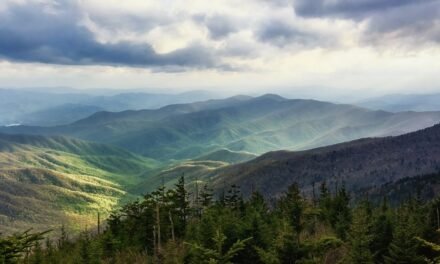Great Smoky Mountains National Park is one of the most visited national parks in the United States, welcoming millions of visitors every year. The park’s diverse landscape, featuring breathtaking mountain vistas, serene forests, and thriving wildlife, offers a unique experience for every visitor. But when is the best time to visit this beautiful park? In this blog, we’ll dive into the various seasons and factors that contribute to the overall experience of visiting Great Smoky Mountains National Park, such as visitor numbers, weather, wildlife, flora, and visitor activities.
Overview of the Seasons
Spring (March-May)
Spring is a time of renewal in the Great Smoky Mountains, with blooming wildflowers, budding trees, and awakening wildlife. The weather during this season is mild and pleasant, making it a great time for outdoor activities. However, spring can also be quite busy, as many visitors flock to the park to witness the vibrant display of nature coming to life.
Summer (June-August)
Summer is the peak season for visiting Great Smoky Mountains National Park, as families and tourists take advantage of the warm weather and summer vacations. The park’s facilities and programs are in full swing during this season, but the increased number of visitors can also mean crowded trails and attractions. The weather in summer can be hot and humid, with occasional thunderstorms.
Fall (September-November)
Fall is a popular time to visit the park due to the stunning display of fall foliage. The vibrant colors of the leaves, combined with crisp air and comfortable temperatures, create a picturesque setting for hiking and exploring the park. Visitor numbers begin to decrease in late October and November, offering a more peaceful experience for those who prefer fewer crowds.
Winter (December-February)
Winter in the Great Smoky Mountains offers a tranquil, serene experience for those willing to brave the colder temperatures. The park’s beauty takes on a different form as snow and ice blanket the landscape. Visitor numbers are significantly lower during this season, but many facilities and roads may be closed due to weather conditions.
Visitor Numbers by Month
Understanding the visitor numbers by month can help you plan your visit to avoid the busiest times at the park. Here is a general breakdown of the average monthly visitor numbers:
- January: 190,000 visitors
- February: 215,000 visitors
- March: 310,000 visitors
- April: 490,000 visitors
- May: 540,000 visitors
- June: 590,000 visitors
- July: 690,000 visitors
- August: 650,000 visitors
- September: 520,000 visitors
- October: 650,000 visitors
- November: 380,000 visitors
- December: 240,000 visitors
As you can see, the summer months (June, July, and August) are the busiest, with the highest visitor numbers. October is also a busy month due to the fall foliage. The winter months (December, January, and February) are the least crowded, while spring and early fall offer a balance between moderate visitor numbers and favorable weather conditions.
Weather Conditions by Season
Weather plays a significant role in determining the best time to visit Great Smoky Mountains National Park. Let’s take a closer look at the average temperatures and precipitation levels for each season.
Spring Weather
- March: High 61°F (16°C), Low 35°F (2°C)
- April: High 70°F (21°C), Low 42°F (6°C)
- May: High 77°F (25°C), Low 50°F (10°C)
Spring weather in the park is generally mild, with temperatures increasing as the season progresses. Rainfall is common during spring, so be prepared for wet conditions and occasional thunderstorms.
Summer Weather
- June: High 83°F (28°C), Low 58°F (14°C)
- July: High 86°F (30°C), Low 62°F (17°C)
- August: High 85°F (29°C), Low 61°F (16°C)
Summer weather is typically warm and humid, with daytime temperatures in the 80s and nighttime temperatures in the 60s. Afternoon thunderstorms are common during the summer months, so it’s essential to be prepared for sudden weather changes.
Fall Weather
- September: High 79°F (26°C), Low 55°F (13°C)
- October: High 70°F (21°C), Low 42°F (6°C)
- November: High 58°F (14°C), Low 32°F (0°C)
Fall offers comfortable temperatures for outdoor activities, with cooler weather setting in as the season progresses. Rainfall is less frequent than in the spring, but it’s still essential to be prepared for changing conditions.
Winter Weather
- December: High 49°F (9°C), Low 27°F (-3°C)
- January: High 47°F (8°C), Low 24°F (-4°C)
- February: High 51°F (11°C), Low 26°F (-3°C)
Winter temperatures can be quite cold, with daytime highs rarely reaching above 50°F and nighttime lows dipping into the 20s or below. Snow and ice are common, especially at higher elevations, and road closures may occur due to hazardous conditions.
Wildlife and Flora Highlights by Season
Spring
- Wildflower blooms: More than 1,500 species of flowering plants can be found in the park, with peak blooming occurring from late March to mid-May.
- Wildlife activity: As the temperatures warm, animals such as black bears, deer, and elk emerge from their winter slumber, becoming more active and visible throughout the park.
- Birdwatching: Spring migration brings a variety of bird species to the park, making it an excellent time for birdwatching.
Summer
- Fireflies: The synchronous fireflies display, usually occurring in early June, is a unique and mesmerizing natural phenomenon found only in a few places in the world.
- Wildlife spotting: Summer is a great time to observe wildlife, such as black bears, deer, elk, and numerous bird species, as they are more active in the warmer months.
- Greenery: The park’s forests are lush and green during the summer, providing a verdant backdrop for hiking and other outdoor activities.
Fall
- Fall foliage: The vibrant colors of the changing leaves draw visitors from all over the world to the park, with peak colors usually occurring from mid-October to early November.
- Wildlife viewing: Fall is the breeding season for elk, making it an excellent time to observe their behaviors and interactions. Black bears are also more active as they prepare for hibernation.
- Autumn wildflowers: A variety of late-blooming wildflowers can be found in the park during the fall months, adding to the colorful landscape.
Winter
- Snowy landscapes: The park’s mountains and forests take on a serene beauty as they are blanketed in snow and ice, offering a unique and peaceful experience for visitors.
- Winter wildlife: While many animals are less active during the winter months, some species, such as deer and elk, can still be observed in the park.
- Winter sports: Cross-country skiing and snowshoeing are popular winter activities in the park, allowing visitors to explore the snowy trails and landscapes.
Visitor Activities by Season
Spring Activities
- Hiking: With pleasant temperatures and blooming wildflowers, spring is a fantastic time for hiking in the park. Popular trails include the Alum Cave Trail, Charlies Bunion, and Chimney Tops.
- Photography: The vibrant colors and abundant wildlife make spring an ideal time for nature photography.
- Fishing: The park’s many streams and rivers provide excellent opportunities for fishing, with trout being a popular target for anglers.
Summer Activities
- Water activities: Summer is a great time to enjoy water-based activities, such as tubing, swimming, and kayaking, in the park’s numerous rivers and streams.
- Camping: The park’s campgrounds are open and fully operational during the summer months, providing a great base for exploring the park.
- Outdoor programs: Ranger-led programs and educational activities are available throughout the summer, offering visitors a chance to learn more about the park’s history, flora, and fauna.
Fall Activities
- Leaf-peeping: The stunning fall foliage is a major draw for visitors during the autumn months. Scenic drives, such as the Cades Cove Loop Road and Newfound Gap Road, offer spectacular views of the colorful leaves.
- Hiking: With comfortable temperatures and fewer crowds, fall is an excellent time for hiking in the park. Popular trails include the Abrams Falls Trail, Rainbow Falls Trail, and the Appalachian Trail.
- Wildlife watching: Fall is a prime time for observing the park’s diverse wildlife, such as elk, deer, and black bears, as they prepare for the winter months.
Winter Activities
- Winter sports: Cross-country skiing and snowshoeing are popular ways to explore the park’s snowy landscapes during the winter months.
- Photography: The snow-covered mountains and forests offer a unique opportunity for capturing stunning winter images.
- Wildlife viewing: While some animals are less active during the winter, you can still spot deer and elk in the park, offering a peaceful wildlife watching experience.
Conclusion: The Best Season to Visit Great Smoky Mountains National Park
Ultimately, the best season to visit Great Smoky Mountains National Park depends on your personal preferences and interests. Each season offers unique experiences and opportunities for exploration:
- Spring: Ideal for wildflower enthusiasts, budding photographers, and those who enjoy mild temperatures.
- Summer: Best for families and visitors looking to take advantage of warm weather, water activities, and park programs.
- Fall: Perfect for leaf-peepers, hikers, and wildlife watchers who prefer cooler temperatures and fewer crowds.
- Winter: Recommended for visitors seeking a serene, snow-covered experience and those who enjoy winter sports.
By considering factors such as visitor numbers, weather conditions, wildlife activity, flora, and available activities, you can choose the perfect time to visit Great Smoky Mountains National Park and create unforgettable memories.



